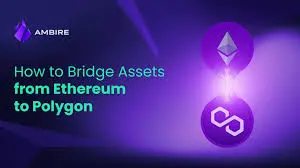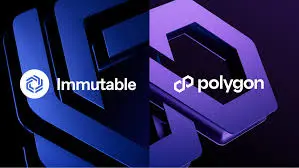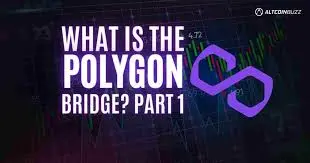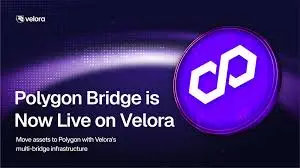Polygon Bridge is a decentralized crypto project designed to facilitate seamless cross-chain transfers between the Ethereum mainnet and Polygon’s Layer 2 sidechain. Launched in May 2021 as part of the Polygon ecosystem, the project’s mission is to solve blockchain fragmentation by enabling fast, secure, and cost-effective asset transfers across different blockchains. Polygon Bridge aims to boost decentralized finance (DeFi), NFTs, and gaming by providing interoperability with usability and scalability.
The goal is to enhance user experience with low transaction fees and faster settlement times compared to traditional Ethereum transactions, achieved through Polygon’s unique protocol innovations.
Official Website: https://wallet.polygon.technology
Whitepaper/PDF: Polygon Bridge Whitepaper PDF (placeholder)
Polygon Bridge Technology Specifications
Polygon Bridge employs a combination of Plasma and POS (Proof-of-Stake) sidechains that ensure secure token transfers without compromising decentralization. The protocol features include:
- Double-spend protection via Plasma checkpoints.
- Validator consensus through Polygon PoS protocol.
- Cross-chain messaging to synchronize assets and smart contract state.
- Compatible with ERC-20, ERC-721, and ERC-1155 token standards.
Blockchain Protocol
Polygon Bridge utilizes Polygon’s PoS sidechain and Ethereum mainnet, supporting interoperability between these blockchains through smart contracts and commit-chain validators.
Polygon Bridge Tokenomics
The primary token associated with Polygon Bridge is MATIC, used for staking, transaction fees, and governance within the Polygon ecosystem. Tokenomics highlight:
- Symbol: MATIC
- Launch Date: April 2019
- Total Supply: 10 billion tokens
- Circulating Supply: Approx. 7.7 billion
- Utility: Securing the network, transaction fees, incentive rewards.
The Polygon Bridge itself facilitates token transfers but does not issue a separate token.
Polygon Bridge Team Information
The team behind Polygon Bridge comprises blockchain veterans and software engineers dedicated to scaling Ethereum. Key members include:
- Jaynti Kanani: Co-founder, ex-Analyst at a major fintech firm, focused on network architecture.
- Sandeep Nailwal: Co-founder, blockchain strategist specialized in Layer 2 solutions.
- Anurag Arjun: Co-founder, front-end lead fostering user experience improvements.
Polygon Bridge Use Cases
Polygon Bridge serves developers, investors, and users by enabling:
- Cross-chain DeFi transactions without high Ethereum gas fees.
- NFT asset transfers between networks, unlocking marketplace interoperability.
- Payment and remittance solutions leveraging fast settlement times.
- Blockchain gaming ecosystems with scalable asset management.
Polygon Bridge Exchange Listings
Polygon’s MATIC token and assets bridged via Polygon Bridge are widely listed across major centralized and decentralized exchanges, including:
- Binance
- Coinbase Pro
- Kraken
- Uniswap
- QuickSwap (Polygon DEX)
Polygon Bridge Storage Options
Users can store bridged assets safely using the Polygon Bridge-compatible wallets, including:
- Polygon Wallet (official web wallet)
- MetaMask (custom RPC for Polygon network)
- Ledger Hardware Wallet (with Polygon integration)
- Trust Wallet
Polygon Bridge Market Analysis
The Polygon Bridge has become a crucial infrastructure component in the rising Layer 2 ecosystem. Increasing adoption of the Polygon network, evidenced by surging MATIC price and active wallets, signals strong market confidence. Polygon Bridge reduces friction from Ethereum’s notorious congestion, making it a preferred solution for NFT and DeFi users worldwide.
| # | Metric | Value | Remarks |
|---|
| 1 | Average Daily Transactions (Polygon Bridge) | Approx. 1.2 million | Steady growth over last 12 months |
|---|
| 2 | Polygon Wallet Active Users | Over 150,000 | Increasing adoption in Q1 2024 |
|---|
| 3 | MATIC Price (Current) | ~$0.95 USD | Market volatility ongoing |
|---|
Latest News about Polygon Bridge
Recent updates highlight Polygon Bridge integration with key DeFi protocols to expand cross-chain liquidity. Polygon partnered with several industry leaders including Aave and SushiSwap for enhanced bridging efficiency. The team announced upcoming security audits and UI upgrades to boost user trust and interface experience.
Educational Content on Polygon Bridge
Beginners and developers can explore detailed tutorials available on Polygon’s official documentation site, covering bridging procedures, token transfers, and wallet setup. Video guides and webinars discuss optimizing cost and gas fees using Polygon Bridge. Educational portals like ClipsTrust provide verified user reviews and expert articles for in-depth learning.
Polygon Bridge Investor & User Reviews
Here are verified reviews from Polygon Bridge users and investors:
- Sarah W. (Rating 5/5): "Polygon Bridge has transformed my DeFi experience with faster, cheaper transfers. Highly recommended for Ethereum users."
- John P. (Rating 4/5): "Reliable and straightforward to use, though UI improvements would enhance usability."
- Mei L. (Rating 5/5): "As a developer, the seamless API integration of Polygon Bridge accelerated our DApp launch."
- David K. (Rating 4/5): "Great cross-chain solution but occasionally latency spikes during high traffic."
- Elena T. (Rating 5/5): "Security audits and strong team governance make this one of the safest bridges available."
Average Rating: 4.6/5
Pros and Cons of Polygon Bridge
Pros:
- Low transaction fees compared to Ethereum mainnet swaps.
- Fast confirmation times leveraging Polygon PoS.
- Compatibility with multiple token standards (ERC-20, ERC-721, ERC-1155).
- Strong community support and open-source transparency.
- Wide wallet and exchange support.
Cons:
- Reliant on Polygon consortium validators, which may raise decentralization concerns for some.
- Bridging speed can suffer during network congestion peaks.
- Users must be careful with contract addresses to avoid phishing scams.
Tips for Polygon Bridge Users & Investors
- Always verify the official website and wallet addresses before transaction.
- Use hardware wallets with Polygon compatibility for maximum asset security.
- Monitor gas fees and bridging times to optimize transfer costs.
- Keep abreast with Polygon’s official announcements for upgrades and audits.
- Diversify your holdings and do thorough research (DYOR) before investing.
Polygon Bridge FAQs
What is Polygon Bridge and how does it work?Polygon Bridge is a cross-chain bridge enabling token transfers between Ethereum and Polygon networks using Plasma and PoS sidechains for secure and scalable operations.
Is Polygon Bridge safe for crypto transfers?Yes, Polygon Bridge uses robust consensus mechanisms and is regularly audited, but users should follow security best practices like verifying URLs and using secure wallets.
Which wallets support Polygon Bridge assets?Polygon Wallet, MetaMask configured for Polygon, Ledger hardware wallets, and Trust Wallet fully support Polygon bridged assets.
Where can I buy or exchange tokens bridged via Polygon Bridge?MATIC and bridged assets are available on major centralized exchanges (Binance, Coinbase, Kraken) and decentralized exchanges like Uniswap and QuickSwap.
How can I contact the Polygon Bridge team for support or partnership?You can reach them via official channels on their website or community platforms such as Telegram and Twitter linked below.
If you find the details according to you and your things fulfilled by a company, then give a review.
ClipsTrust Expert Note
Polygon Bridge stands as a paramount project advancing blockchain interoperability with a strong technical foundation and market adoption. Our analysis validates its innovation, security measures, and active community engagement. As a reliable Layer 2 bridge solution, it opens scalable pathways for DeFi and NFT ecosystems. We encourage users and investors to DYOR and share authentic reviews on ClipsTrust to enhance transparency and build trust in the blockchain space.
For more expert crypto project reviews and trustworthy data, explore the official ClipsTrust YouTube channel and connect with us through socials listed below.
| # | Comparison Feature | Polygon Bridge | Competitor Bridges |
|---|
| 1 | Transaction Fee | Low (avg $0.1 - $0.3) | Higher fees on Ethereum mainnet bridges |
|---|
| 2 | Transaction Speed | ~2-3 minutes | 5-20 minutes depending on network load |
|---|
| 3 | Supported Token Types | ERC-20, ERC-721, ERC-1155 | Mostly ERC-20, limited NFTs support |
|---|
| 4 | Security Mechanism | Plasma + PoS checkpointing | Varied, sometimes none or multi-sig |
|---|
Discover reliable crypto project insights, investment safety tips, and wallet integration tricks all verified by Clipstrust experts. If you find this information useful, please share your review on Clipstrust.


.webp)





.webp)



